Endemic Birds Of Sri Lanka
Birds of Sri Lanka
Sri Lanka is a paradise for birdwatchers, with around 460 recorded bird species, including both resident and migratory birds. Of these, 237 are resident breeders, and 35 species are endemic. Many of these endemics can be seen in the forests of the wet zone and central highlands. Every year, migratory birds arrive from as far as northern Asia, making the island a seasonal haven for species escaping the northern winter.
From colourful forest dwellers and highland endemics to shorebirds and raptors, Sri Lanka’s birdlife is remarkably diverse for its size.Whether you’re an avid birder or a curious traveller, Sri Lanka offers exceptional birdwatching experiences across its national parks, wetlands, and cloud forests—where every call, flash of colour, and flight tells a story of this island’s rich natural heritage.
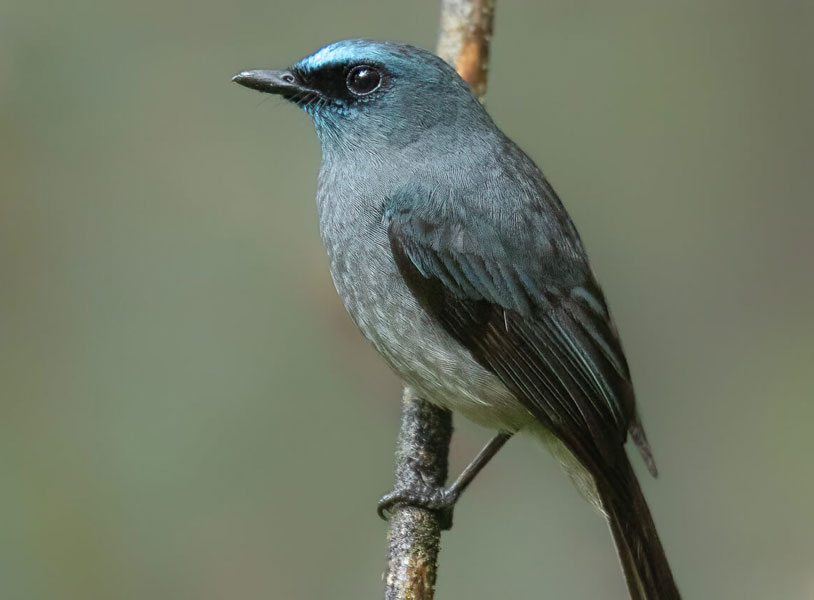
Dull-blue flycatcher (Eumyias sordidus)
The Dull-blue flycatcher is a charming bird found in the hills and mountains of central Sri Lanka, a must-see for birding enthusiasts. With its mostly blue plumage and intense blue forehead, it's easy to spot in the dense, wet forests. Notable features include a black face, a pale grayish belly, and a distinctive black patch between the bill and the eye. Unlike similar blue songbirds, the dull-blue flycatcher has a unique combination of markings. During the breeding season in March and April, they build cup-shaped nests on shaded rock ledges, laying two or three brown-spotted pink eggs. They have a lovely melodic song and give short "chip" calls. Despite living in the forest, they are relatively easy to see as they feed on flying insects, beetles, caterpillars, and berries, making them a delightful sight for tourists.
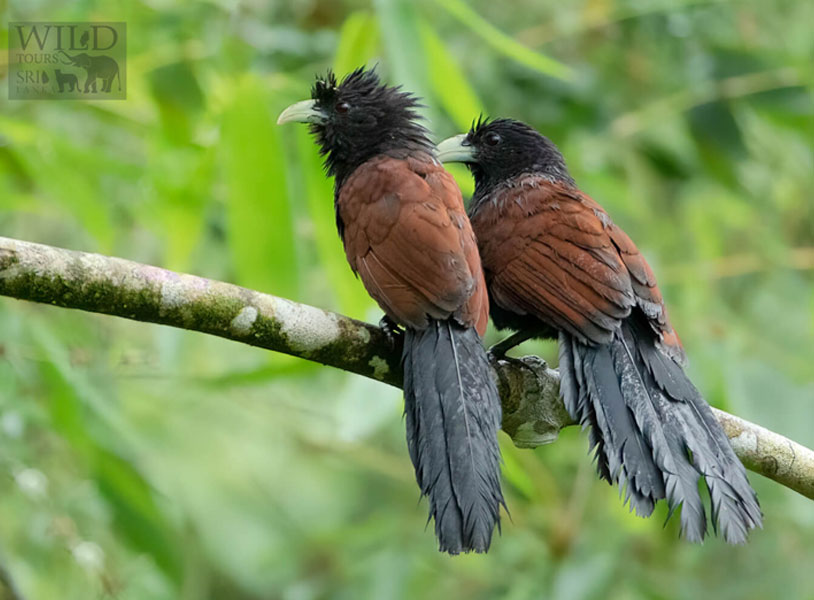
Green-billed coucal (Centropus chlororhynchos)
The Green-billed Coucal, a mid-sized bird inhabiting lowland and mid-hill forests in Sri Lanka, is characterized by its black plumage with a purplish sheen, dark rufous wings, and a distinctive pale, greenish bill. Typically found in the dense undergrowth of humid forests, this coucal is elusive and often challenging to spot, being more frequently heard than seen. The light green bill is a key feature that sets it apart from its larger relative, the Greater Coucal. The species emits a series of deep, double “boop-boop” notes or a regular, upslurred “ker-chuip” or “chuip,” resembling a stone dropping into water. Despite its distinctive call and size, the Green-billed Coucal proves difficult to observe due to its retiring nature and the dense habitat it prefers. This bird sustains itself on a varied diet, consuming insects, caterpillars, small vertebrates, with a particular fondness for snails.
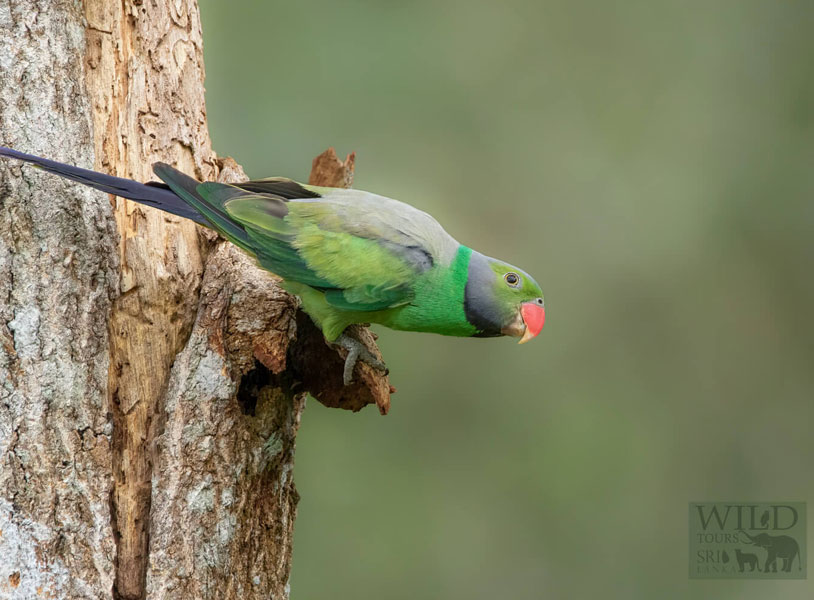
Layard’s parakeet (Psittacula calthrapae)
The vibrant Layard's Parakeet, a long-tailed parrot endemic to Sri Lanka, showcases a brilliant green plumage complemented by a distinctive gray hood and a conspicuous black throat. The male's bill is a striking red-orange on the upper mandible, while the lower mandible is brown. Females, on the other hand, have an all-black beak and less green on the face compared to males. Immature birds mainly sport vibrant green plumage, with an orange bill. Among the upper levels of humid forests in the Wet Zone and drier wooded areas, these parrots form small groups that inhabit both lowlands and hills. These gregarious and noisy birds can often be heard emitting a raucous "ak-ak-ak-ak-ak." Their vivid colors and lively calls make them a highlight for birding tours in Sri Lanka
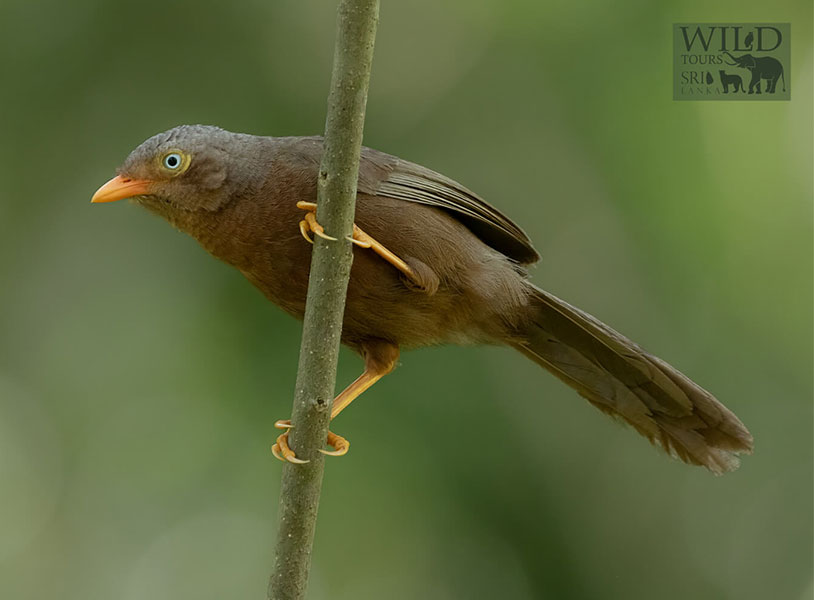
Orange-billed babbler (Argya rufescens)
The Orange-billed Babbler is a conspicuous bird inhabiting the rainforests of the wet zone in Sri Lanka. Rarely straying from the deep jungle, it is characterized by plain orange-brown plumage below and a slightly darker shade above, with a grey crown and nape. The bird boasts a distinctive orange bill and feet, complemented by a beady yellow eye. Typically found in flocks of seven to ten or more, these babblers are highly gregarious and emit continual chattering, squeaking, and chirping sounds, serving as the first sign of a mixed-species feeding flock in the vicinity. Nesting in trees concealed within dense foliage, the Orange-billed Babbler lays two or three deep greenish-blue eggs. Despite its weak flight due to short rounded wings, this non-migratory bird feeds mainly on insects and jungle berries.
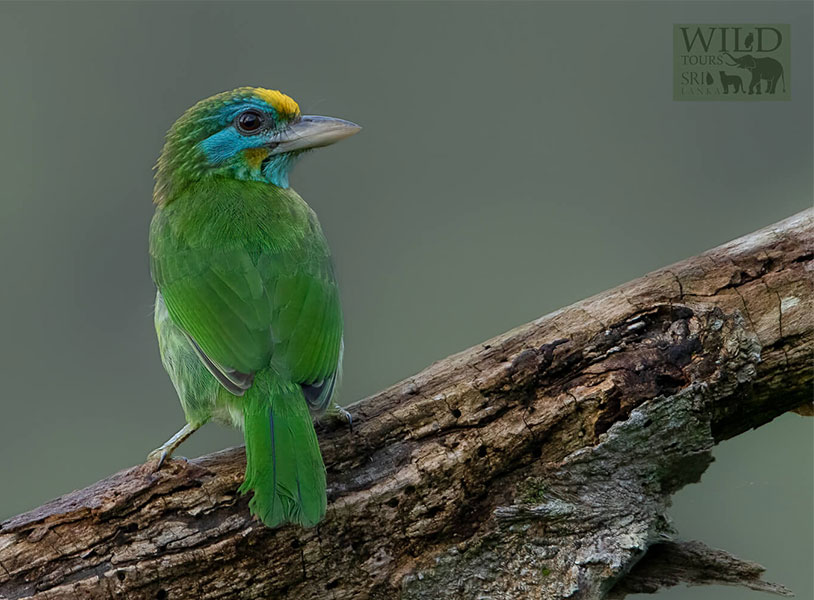
Yellow-fronted barbet (Psilopogon flavifrons)
The Yellow-fronted Barbet, an Asian endemic resident breeder in Sri Lanka, finds its habitat in subtropical and tropical moist forests, wetlands, plantations, and rural gardens up to an altitude of 2,000 m. With its green plumage, distinctive yellow crown, and blue patches below the eyes, throat, and chin, this barbet measures 21–22 cm in length and weighs 57–60 g. Inhabiting the canopy, it is often seen alone or in pairs within forested environments in the lowlands and foothills, with a preference for the Wet Zone. The Yellow-fronted Barbet's song is a repetitive explosive "ke-cheer," while its calls include a rolling and rising "pup-pup-pup-pup." Feeding on berries, fruits, and occasional insects, it nests in tree holes, laying 2-3 eggs.
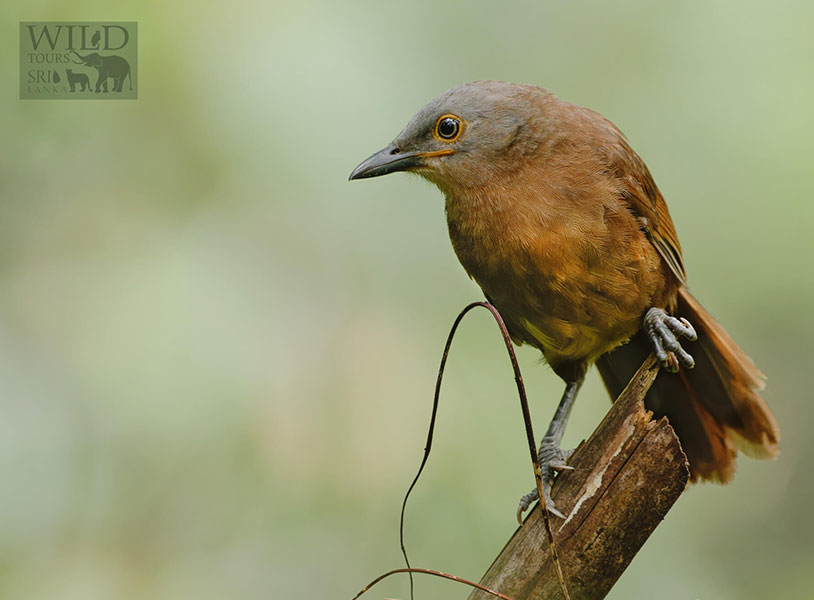
Ashy-headed laughingthrush (Argya cinereifrons)
The Ashy-headed laughingthrush, a medium-sized rufous babbler, stands out with its distinct features—a gray hood, beady pale eye, buff throat patch, and blackish bill and legs. Typically found in small groups within the understory of wet forests in the lowlands and foothills of Sri Lanka, this gregarious bird can also join mixed species flocks. Emitting a variety of vocalizations, including scratchy notes, whistles, squeals, metallic "churrs" and "chirps," and chattering calls, the ashy-headed laughingthrush adds its lively soundscape to the rainforest. It builds nests in bushes concealed within dense foliage, laying three or four eggs. The vibrant sounds of this bird enhance the overall birding experience in Sri Lanka’s rich biodiversity.
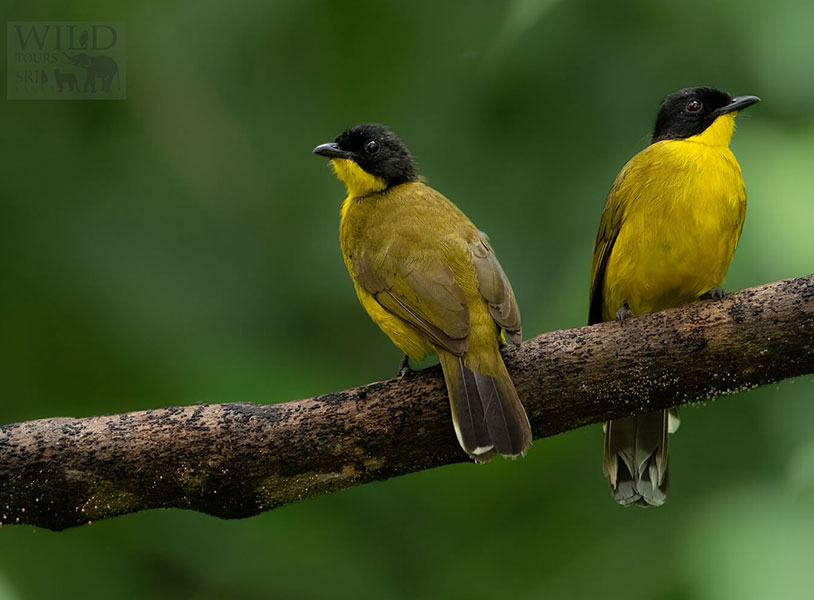
Black-capped bulbul (Rubigula melanictera)
The Black-capped bulbul is a medium-sized bird with a yellow throat, bright yellow underside, and a black head. It has brownish eyes, and the male has red irides, while the female has brown irides. Known for its sweet, mellow, minor-key piping whistles and sharper calls, this bulbul breeds from March to September in forests, dense scrub, and gardens. It builds nests in bushes, typically laying two to four eggs. Feeding on fruit and insects, the black-capped bulbul is versatile, found in various habitats, including forests, open woodlands, and gardens, in the lowlands and foothills. Often seen in pairs or small groups, this charming bird adds to the allure of birding in Sri Lanka.
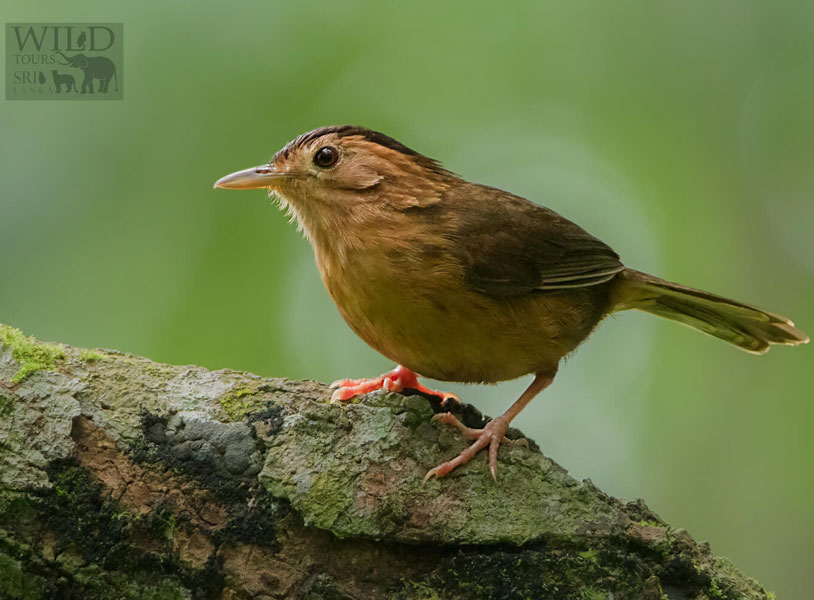
Brown-capped babbler (Pellorneum fuscocapillus)
The Brown-capped babbler is a small and distinctive bird in Sri Lanka. It measures 16 cm in length, including its long tail, and is brown above and rich cinnamon below, featuring a dark brown crown. It is typically found on or near the ground in forests, forest edges, and wooded areas, often in pairs. This species has a limited range on the island. Despite being challenging to spot in dense vegetation, these babblers are noisy birds, and their repetitive three-note whistle "wit-wi-yoo," ascending at the start and descending at the end, is a distinctive sound in their habitat. Their calls, including more complex warbles, provide a reliable indication of their presence.
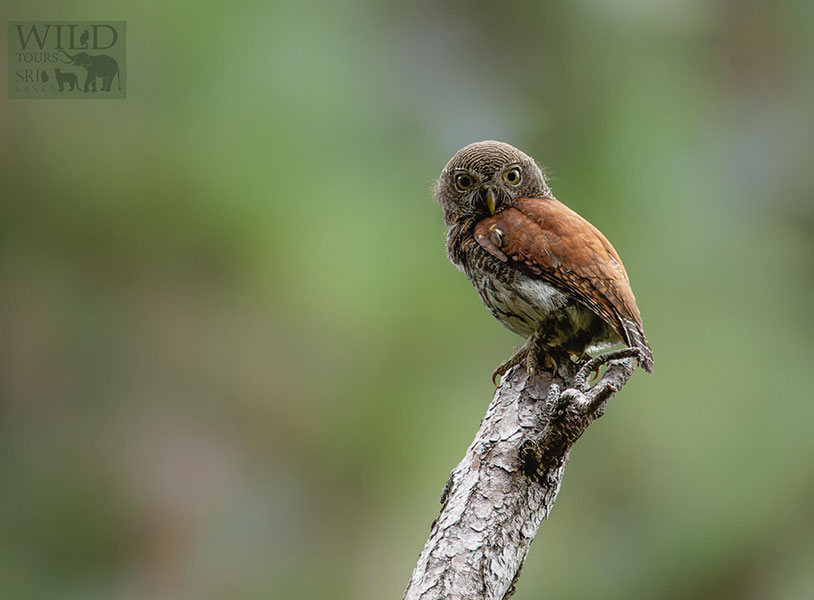
Chestnut-backed owlet (Glaucidium castanotum)
The Chestnut-backed owlet is a small and stocky bird, measuring 19 cm in length, with a distinctive appearance characterized by chestnut brown upperparts and a pale belly with streaked flanks. Lacking ear tufts, this owl is crepuscular and diurnal, often seen singly or in pairs in wet rainforests or neighboring woods. It stands out from the similar Jungle Owlet with its chestnut back and streaked flanks, and it has a preference for the wetter regions of Sri Lanka. The bird's call is a series of barbet-like "kurr-kurr-kurr" notes, often followed by harsh "kao-kao" yaps, resembling the Jungle Owlet but slightly lower-pitched. Once a common resident in the wet zone forests, it is now found sparingly in the remaining forests at altitudes of up to 6,500 ft above sea level, making it a unique sight.
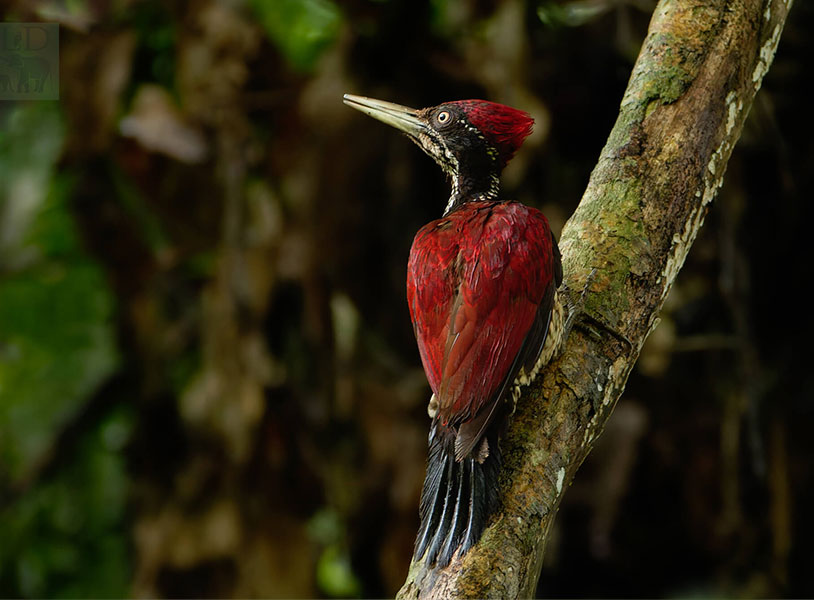
Crimson-backed flameback (Chrysocolaptes stricklandi)
The Crimson-backed woodpecker is a large and spectacular bird endemic to Sri Lanka. With its stunning crimson upperparts, black-scaled pale underparts, and a crested head, it's an eye-catching species. Males sport a red crest, while females have a black crest with fine white markings. Unlike the similar Red-backed Flameback, it lacks a prominent white eyebrow. Typically found in pairs in the understory of forests and woodlands, this woodpecker often joins mixed species flocks and can occasionally be spotted in disturbed areas or home gardens. The bird's frequent calls include a rapid, fast-paced, high-pitched trill that gets quieter and decelerates at the end, as well as a fast-paced, descending drum. Both the call and drum distinguish it from the more common Red-backed Flameback.
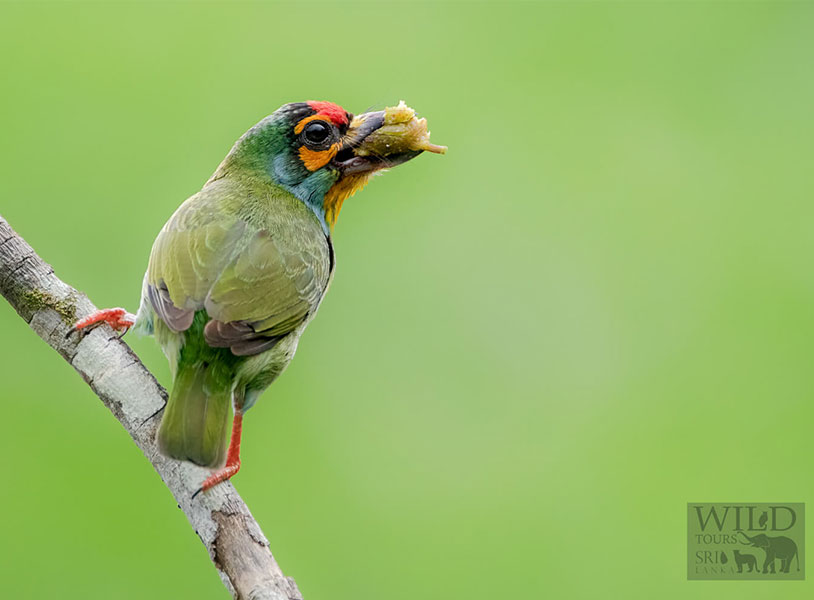
Crimson-fronted barbet (Psilopogon rubricapillus)
The Crimson-fronted barbet is a small, green bird with a red forehead, light orange markings around the eye, and blue sides to the face, standing out at 15 cm in length. With its mainly green plumage and wings, as well as a distinctive black crescent behind the eye, it is easily recognizable. Distinguished from the Yellow-fronted Barbet by its smaller size and red forehead, and from the Coppersmith Barbet by lacking streaks below. Often found foraging for fruit and insects, this barbet nests in tree holes, laying 2-4 eggs. Its incessant calls from treetops make it easily locatable in open wooded areas, gardens, forests, and forest edges in the lowlands and foothills. This bird is a highlight for birding enthusiasts on tours focused on the endemic birds of Sri Lanka and is frequently seen during eco-tourism trips. Its song is characterized by an incessant "pop-pop-pop-pop," with faster call notes like "opopopopop."
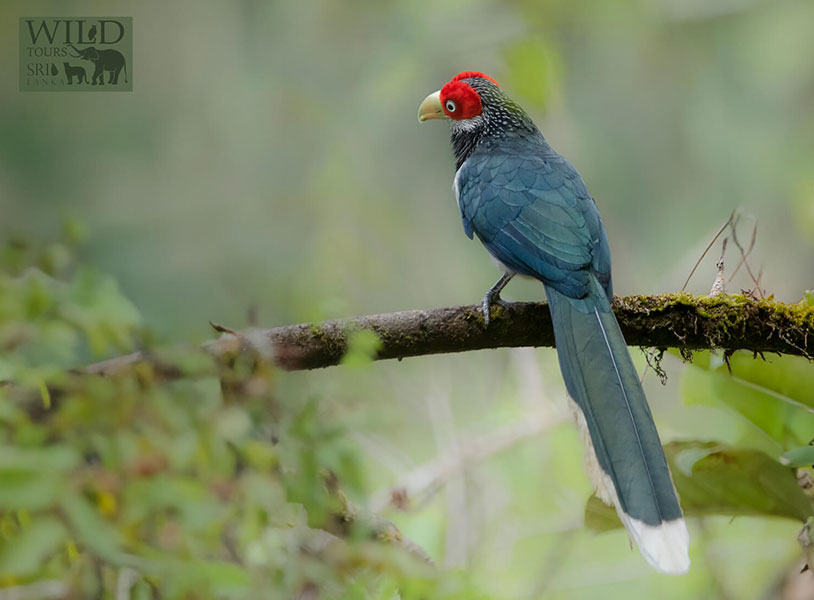
Red-faced malkoha (Phaenicophaeus pyrrhocephalus)
The Red-faced malkoha is a large bird, measuring 46 cm, with a distinctive appearance. Its back is dark green, and the uppertail is green edged with white, while the belly and undertail are white with black barring. The crown and throat are black, and there's a large red patch around the eye, complementing the green bill. Males have dark brown irises, and females have creamy white irises, showcasing sexual dimorphism. Juveniles have duller plumage. This malkoha primarily feeds on insects like caterpillars, giant stick insects, mantises, and small vertebrates such as lizards. Though often elusive, spotting this species during birding tours through Sri Lanka’s diverse forests is a rare delight. Found in dense forests, it can be challenging to spot despite its size and vibrant colors.
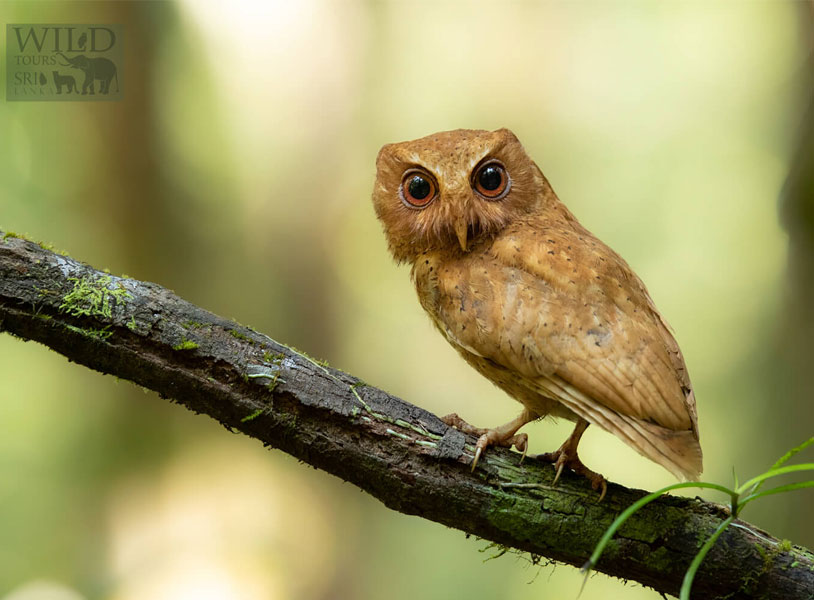
Serendib scops owl (Otus thilohoffmanni)
The Serendib scops owl is a very small and rare owl found in the rainforests of the southwestern part of Sri Lanka. With its distinctive reddish-brown color, yellow-orange eyes, and sparse light speckles on the underparts, it is easily recognizable. Although lacking true ear tufts, it can display "false" ones when alert. Roosting singly or in pairs in the understory, it is strictly nocturnal, hunting insects close to the ground. For birding enthusiasts and those on specialized wildlife tours, encountering this owl is a unique experience due to its rarity among the endemic birds of Sri Lanka. Its population is small, with only 80 known individuals by January 2006, and it faces threats from habitat loss and degradation.
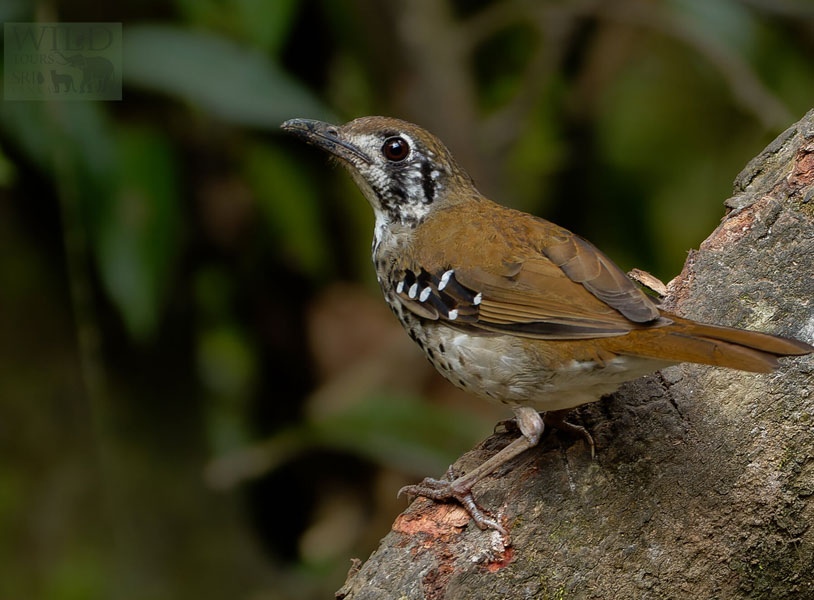
Spot-winged thrush (Geokichla spiloptera)
The Spot-winged thrush is a distinctive brown thrush found in Sri Lanka, recognized by bold dark spots on the underparts, white spots in the wings, and black facial stripes below the eye. Occurring in pairs or singly on the ground in forested areas, gardens, and forest edges, primarily in the Wet Zone, it is easily distinguished by the distinct rows of white spots on the wings and bold spotting below. A favorite for birding enthusiasts on tours exploring the endemic birds of Sri Lanka, this thrush’s musical talents are captivating, as it emits a high-pitched "sweeeee" call with rich, melodious whistles and warbles.
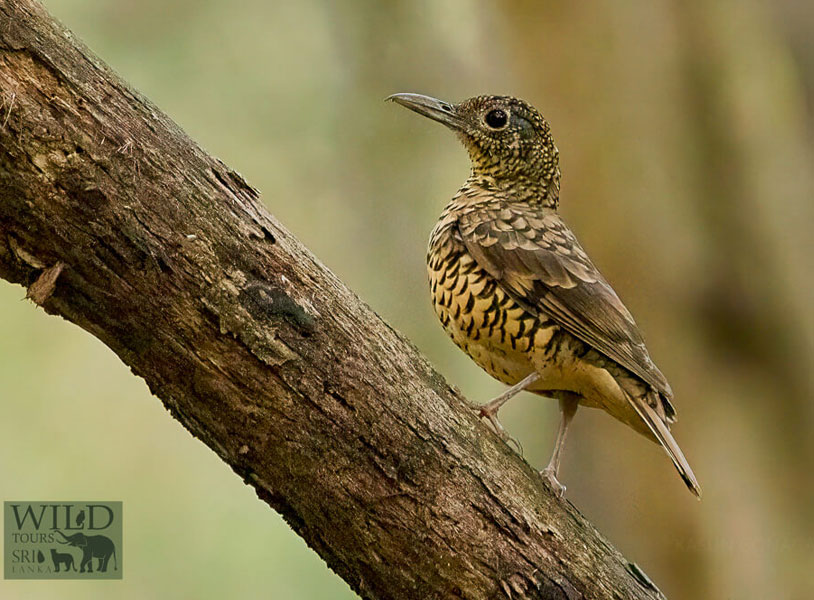
Sri Lanka thrush (Zoothera imbricata)
The Sri Lanka thrush is a brown thrush distinguished by extensive black scales covering its body and rich buff underparts. With its long bill and a preference for the understory of wet forests in lowlands and mountains, this terrestrial species is commonly found foraging along forest tracks, especially in the foothills. For visitors interested in wildlife tourism, particularly focused on the endemic birds of Sri Lanka, this bird is an elusive prize. Its mournful, unobtrusive song—"cheeew-chew-lew"—makes it a signature sound in its preferred habitats.
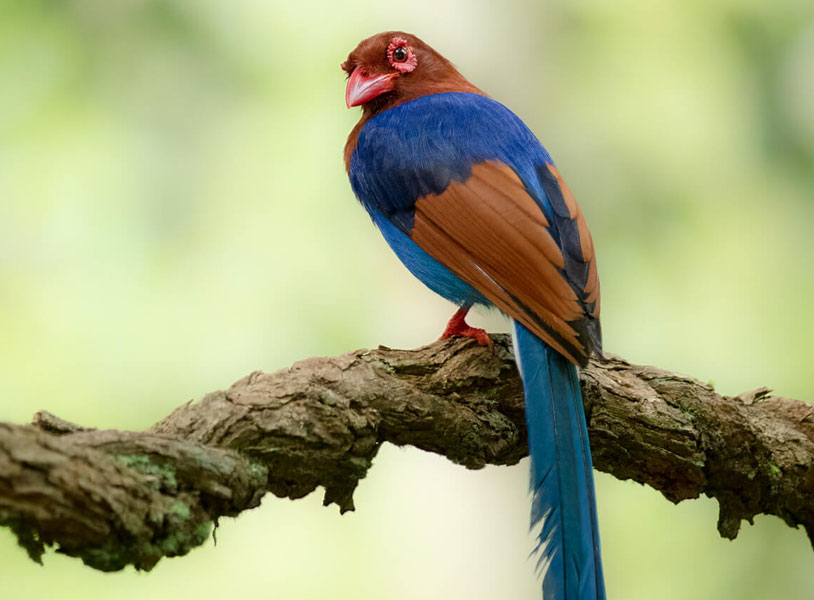
Sri Lanka blue magpie (Urocissa ornata)
The Sri Lanka blue magpie, measuring between 42 and 47 cm, falls in size between a mynah and a crow, characterized by its vibrant blue plumage. With a reddish-brown or chestnut head, neck, and wings, this magpie boasts a long, graduated blue tail with a white tip. Both males and females share these features, and the vibrant red extends to its bill, legs, feet, and featherless eye ring. Juveniles resemble adults but have a duller overall appearance, a brown eye ring, and a greyish hue to their blue feathers, especially on the underside. Moulting season occurs from August to November. Inhabiting humid forests from lowlands to hills, the Sri Lanka blue magpie often accompanies mixed canopy flocks, either singly or in small groups. Its distinct calls include high-pitched, piercing "clink" sounds and rasping "krak" notes, making it a noisy and unique presence in its habitat.
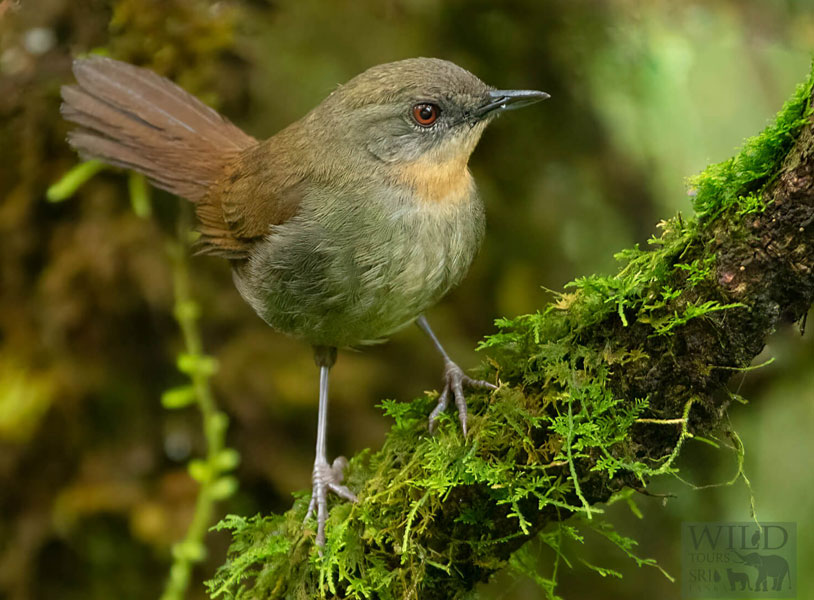
Sri Lanka bush warbler (Elaphrornis palliseri)
The Sri Lanka bush warbler is a small, earthy-brown bird with a graduated tail, distinguished by its rich, buffy throat, short, indistinct grey eyebrow, and pale iris. Typically found singly or in pairs within wet vegetation in the understory of hills and mountains in Sri Lanka, usually above 1200 meters. This elusive bird is a sought-after sight during birding expeditions in Sri Lanka’s highlands. Its song is described as "chiwee-chiwee-chiwee" and, like many of the endemic birds of Sri Lanka, contributes to the rich avian biodiversity celebrated in eco-tourism.
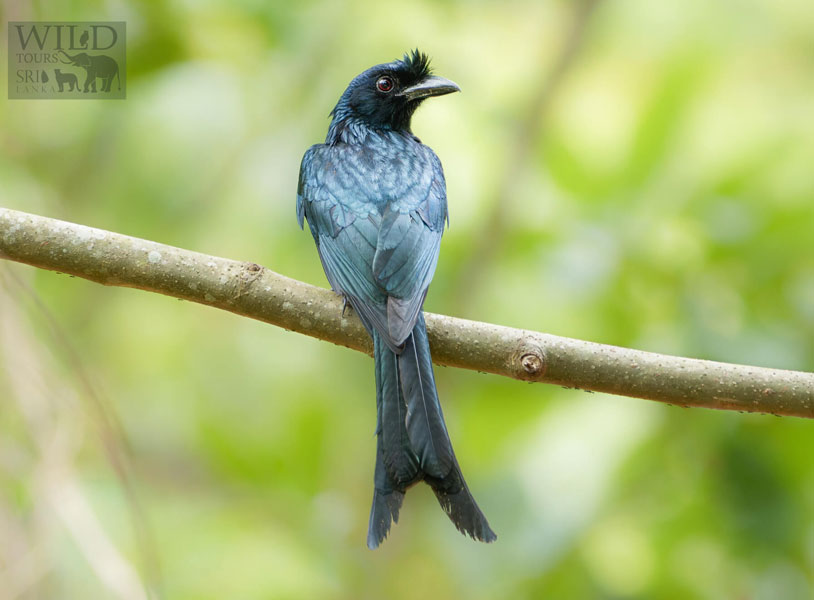
Sri Lanka drongo (Dicrurus lophorinus)
The Large-billed drongo is a sizable, upright, blackish bird recognized by its long, deeply-forked tail and a tuft of feathers on its forehead. Commonly found in pairs and often in mixed flocks, it inhabits the understory of humid forests in the lowlands and foothills of Sri Lanka's Wet Zone. Its vocal presence and diverse repertoire make it an exciting species to encounter on tours focused on the endemic birds of Sri Lanka.
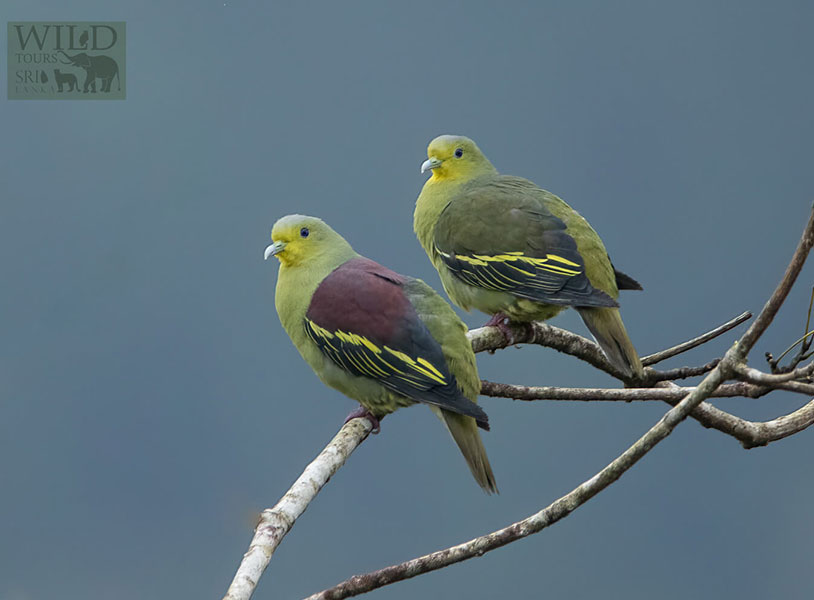
Sri Lanka green pigeon (Treron pompadora)
The Sri Lanka green pigeon is a medium-sized green pigeon distinguished by its yellow face and a yellowish line on the wing. Typically found alone or in small groups at the upper levels of forests in both lowlands and hills, the maroon back of the male distinguishes it from similar species. Birding tours in Sri Lanka often focus on locating this pigeon, a highlight for those interested in the country’s unique avifauna. Its diet includes seeds and fruits from various plants, and it builds stick nests in trees, where it lays two white eggs.
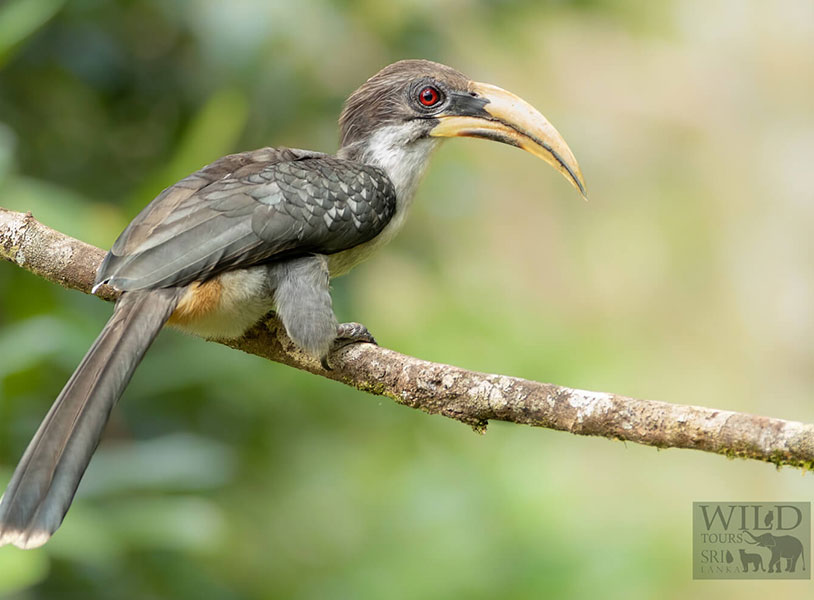
Sri Lanka grey hornbill (Ocyceros gingalensis)
The Sri Lanka Grey Hornbill is a large bird, measuring 45 cm in length, with distinctive features such as grey wings, a brown crown, and a blackish tail with white sides. Its appearance and distinct song make it a focal point of wildlife tourism in Sri Lanka. Often found in pairs or groups in forested areas, particularly drier regions, this hornbill is a key species in the birding itineraries of the country's rich tourism offerings. Its song is characterized by an accelerating "kok-kok-kok" ending in a cackle.
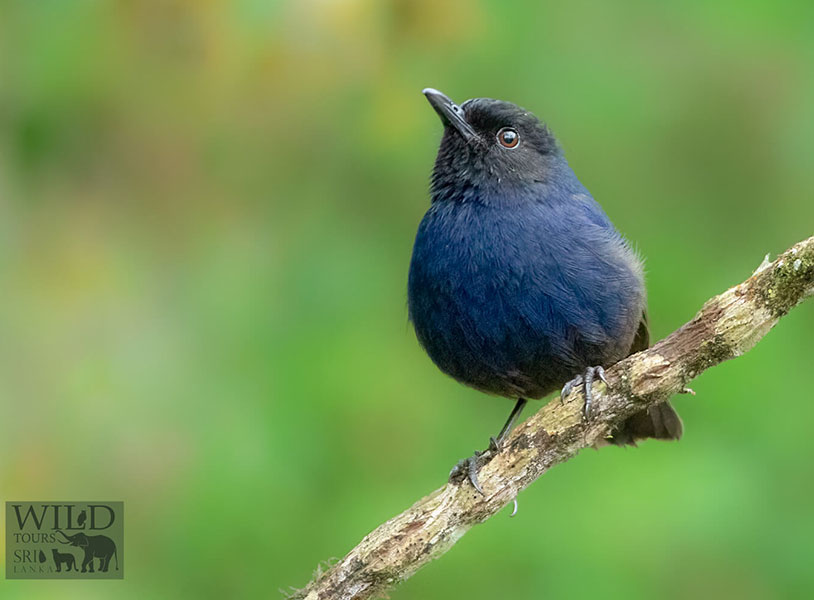
Sri Lanka Whistling Thrush (Myophonus blighi)
The Sri Lanka whistling-thrush is a small and elusive bird inhabiting the highlands of Sri Lanka, particularly in dense forests near water. An omnivore, it feeds on insects, frogs, earthworms, and berries. Nesting in cup-shaped nests, this solitary bird lays one or two eggs on bushes or ledges near water. Males display dark blue plumage with vibrant blue patches, while females are brown above and chestnut below, with a blue shoulder patch. Due to habitat loss, this species is declining and notoriously difficult to spot, making it a rare find for birders.
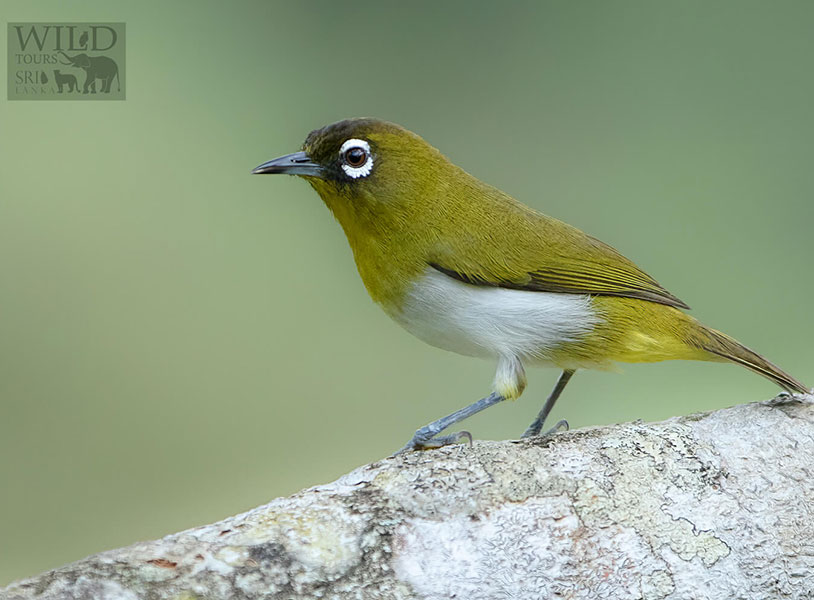
Sri Lanka White-eye (Zosterops ceylonensis)
The Sri Lanka white-eye is a small, greenish bird distinguished by its bold white eye ring and yellow throat. Typically found in active flocks within the canopy of forests and adjacent wooded areas, it is slightly larger than the Indian White-eye but lacks the yellow forehead. Sociable in nature, it forms large flocks that disperse during the breeding season. This bird builds nests in trees and lays three unspotted pale blue eggs. While primarily insectivorous, it also consumes nectar and various fruits.
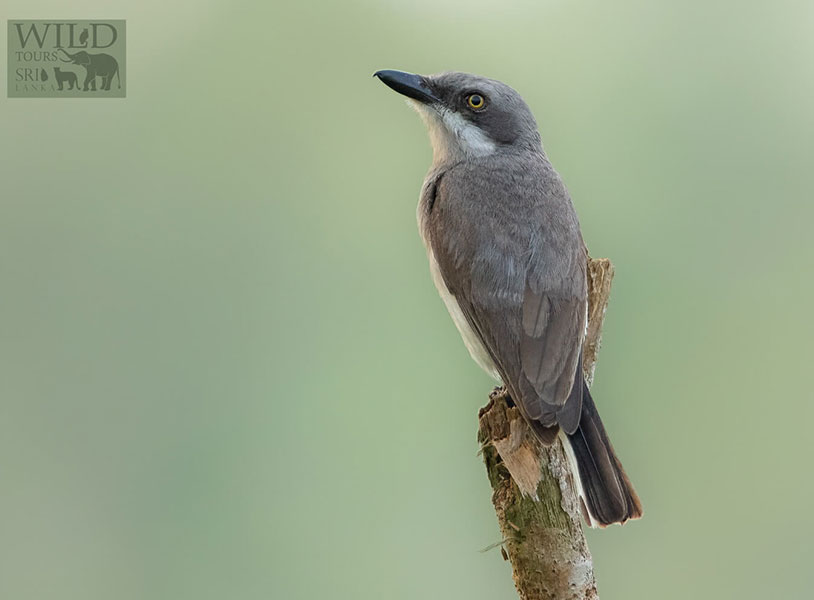
Sri Lanka Woodshrike (Tephrodornis affinis)
The Sri Lanka woodshrike is a small gray songbird characterized by its hefty bill, dark mask, and distinctive white eyebrow. Its underparts are pale whitish, and in flight, a white rump is noticeable. Typically found in wooded areas and scrub in the lowland and lower hills, mainly in the Dry Zone of Sri Lanka, it avoids dense, wet forests. This arboreal species is commonly encountered in pairs or small groups. The Sri Lanka woodshrike communicates with soft "chup" notes, and its song is a resonant series of "wee-wee-weet-weet" notes, varying in rapidity and the number of notes in a series.

Sri Lankan Junglefowl (Gallus lafayettii)
The Sri Lankan junglefowl is a wild chicken-like bird with distinct characteristics in males and females. The male exhibits burnt orange plumage with dark streaks, a glossy black cockerel-like tail, and a striking red comb marked with yellow on the crown. Females, on the other hand, have gray-brown feathers with white streaks and prominent barring on the wings. These terrestrial birds are usually found in pairs or small groups in the forests of both lowlands and highlands across Sri Lanka, often staying close to cover. The male Sri Lankan Junglefowl's song is a harsh "chyok-cher-chow," accompanied by stuttering "kik-kik-kik-kik" notes.
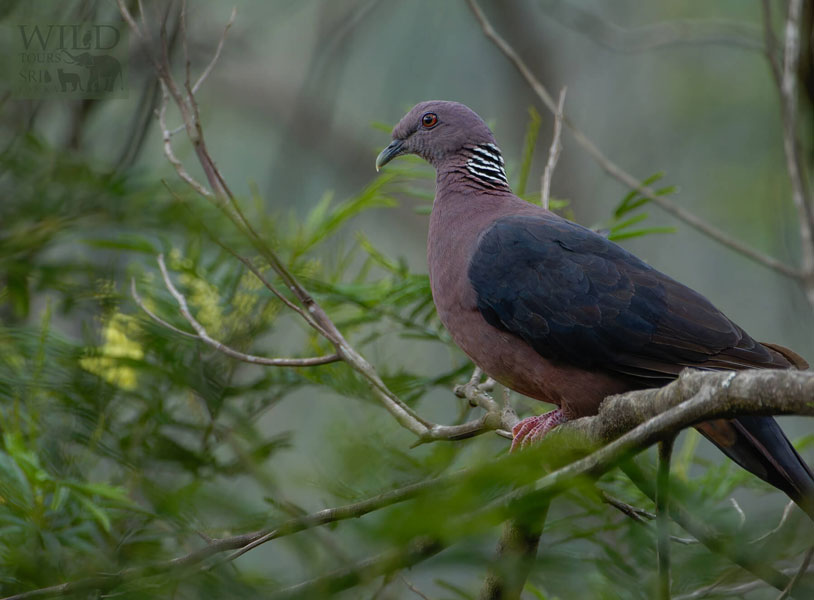
Sri Lankan Wood Pigeon (Columba torringtoniae)
The Sri Lanka wood pigeon is a large, plain gray pigeon characterized by conspicuous black-and-white stripes on the nape and mauve-flushed underparts. Typically found in the upper levels of forests and densely wooded areas, these pigeons are seen in pairs or small flocks. Their vocalizations include a deep "wooo" and an owl-like double-note "woo-oo," making them a unique addition to Sri Lanka's avian diversity.
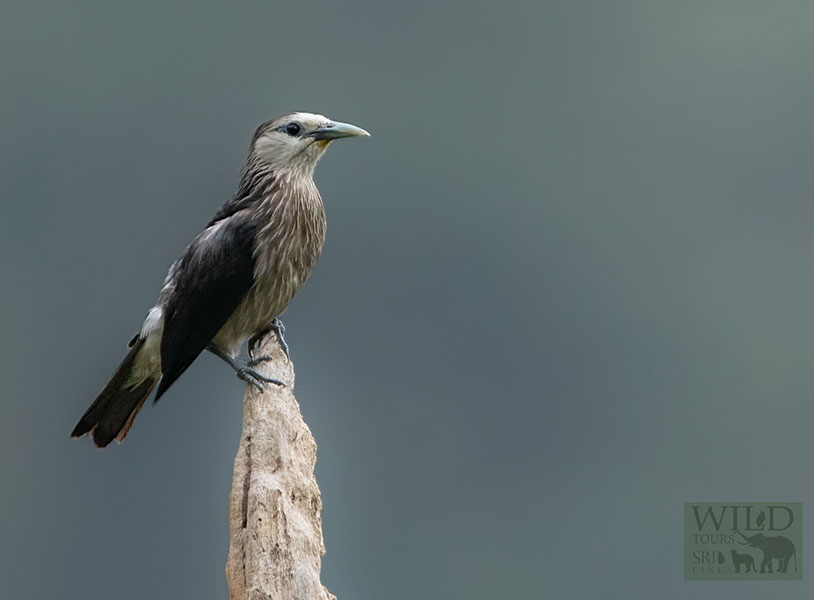
White-faced Starling (Sturnornis albofrontatus)
The White-faced starling is a small starling with dark-backed features and a distinct white face. Adults, measuring 22 cm, have green-glossed dark gray upperparts and whitish underparts. Often seen in pairs within the forest canopy of lowlands, their typical call is a harsh "chyup," with songs that are a blend of warbles and scratchy notes, making them an interesting species to observe during birding tours.
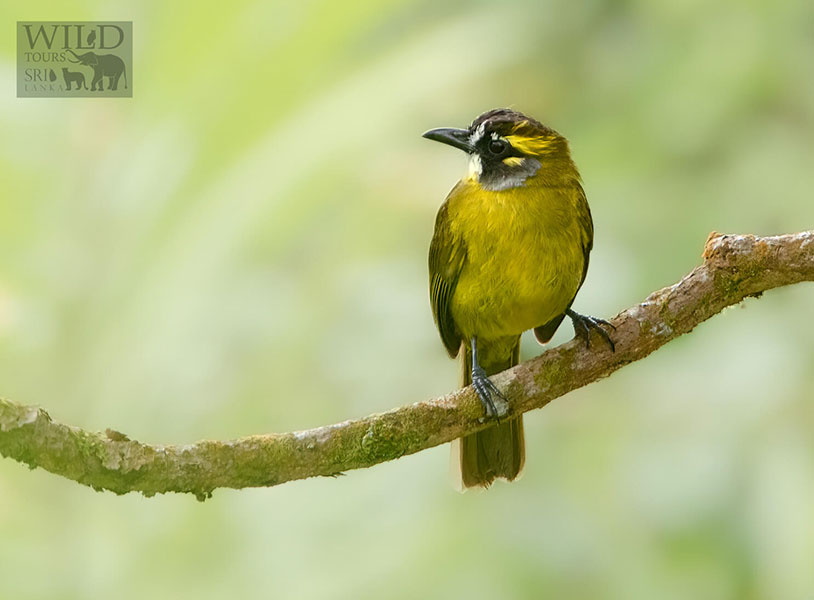
Yellow-eared Bulbul (Pycnonotus penicillatus)
The Yellow-eared bulbul, an endemic species in Sri Lanka, stands out as the least common among the bulbuls in the region. Typically found in jungles and wooded farmlands. Measuring about 20 cm with a long tail, it features olive upperparts and yellowish underparts. The head boasts a grey crown, yellow ear tufts, and a patch below the eye, complemented by a white tuft in front of the eye and a white throat. While the sexes share similar plumage, young birds appear duller than adults. Noteworthy is its woodpecker-like, bouncing flight. The Yellow-eared bulbul moves in small parties. A harsh trill and a song comprising high "whit" whip-like notes are characteristic vocalizations.
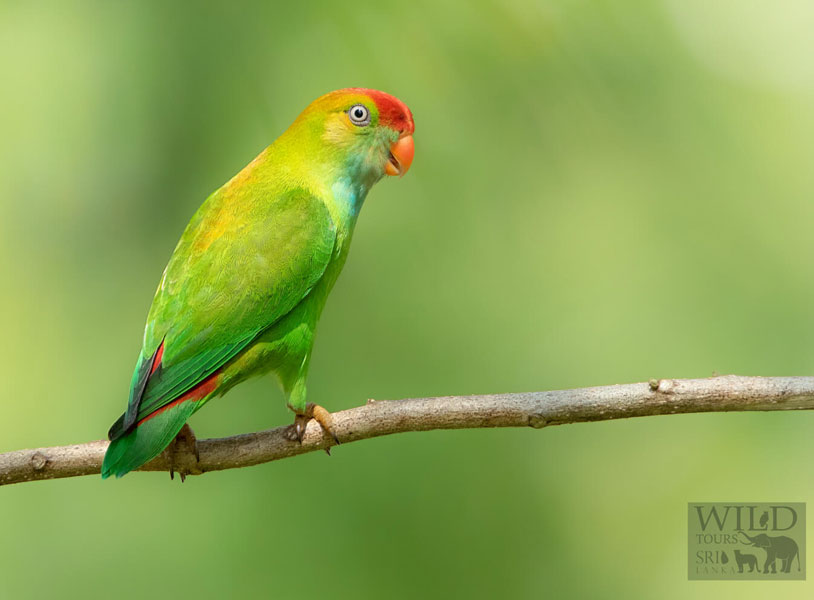
Sri Lanka Hanging Parrot (Loriculus beryllinus)
The Sri Lanka hanging parrot is a petite and brightly colored avian, measuring around 13 cm. With a striking red crown and rump, an orange-tinted back, and a pale blue chin and throat, this bird is less social than some relatives, often seen alone or in small groups. Their swift flight and sharp whistled calls make them a delightful sight in Sri Lanka’s forests.
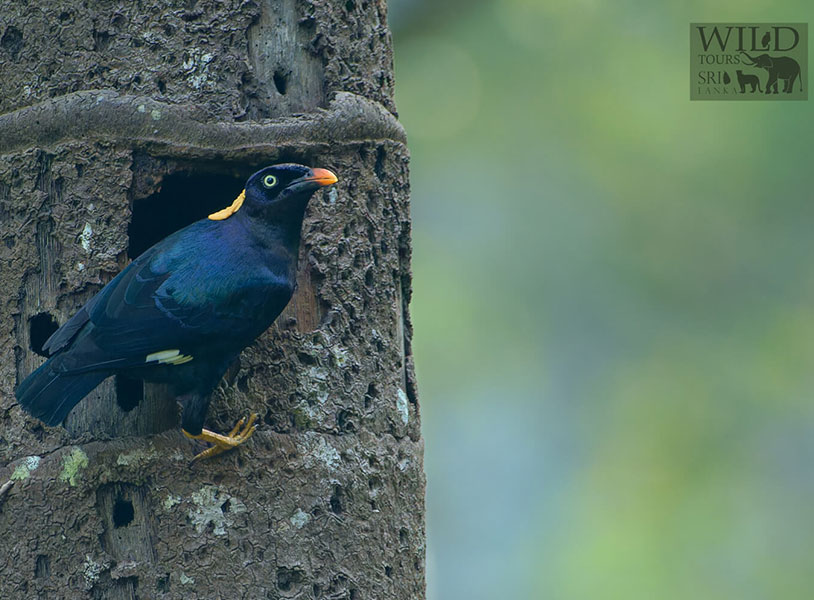
Sri Lanka Myna (Gracula ptilogenys)
The Sri Lanka myna is a medium-sized black starling found in forests and cultivated areas. With green-glossed black plumage and purple-tinged features, these birds measure about 25 cm. They are omnivorous and commonly seen in small groups, often engaging in various calls, including a strident "chewp." Their nests, typically built in tree holes, and their diet make them an integral part of Sri Lanka's diverse ecosystem.
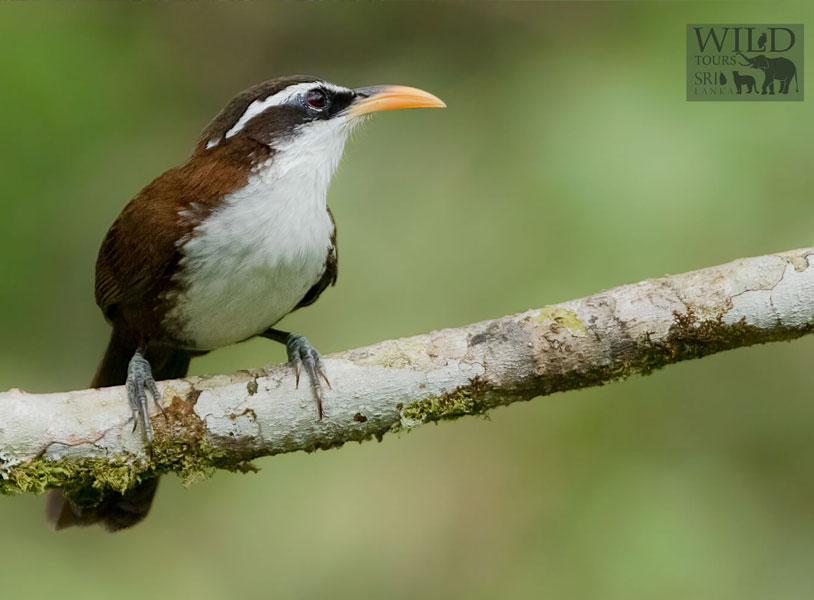
Sri Lanka Scimitar Babbler (Pomatorhinus melanurus)
The Sri Lanka babbler is a visually striking bird, characterized by its long, bright yellow-orange downcurved bill, bold white eyebrow, deep chestnut upperparts, and clean white underparts. Found in forested areas and nearby scrub in both lowlands and mountains, it usually moves in pairs or mixed species flocks. Its distinctive song consists of staccato "yee-doo-doo-doo" notes, and it may engage in duets with a second bird uttering a strident "ker-trick." During the breeding season from December to February, it is often seen in pairs. The Sri Lanka babbler feeds on insects, grubs, spiders, flower nectar, and berries, foraging on the ground or in dense undergrowth. The nest, constructed from loose materials, is usually concealed in dense foliage on a bush or on the ground, where it lays 2 to 5 eggs.
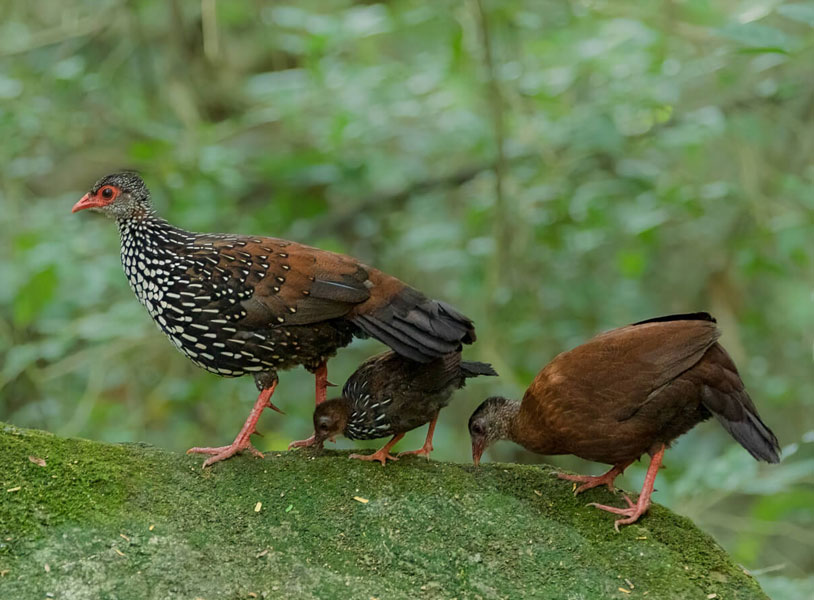
Sri Lanka Spurfowl (Galloperdix bicalcarata)
The Sri Lanka spurfowl is a secretive bird that can be challenging to spot due to its elusive nature and preference for dense undergrowth. Recognizable by its distinct ringing call, a series of three-syllabled whistles, it is often heard rather than seen. With a length of approximately 37 cm, both male and female exhibit brown upperparts, wings, and tail. The male stands out with vivid crimson red legs, bare facial skin, and striking black and white dorsal plumage extending to its head. The females have chestnut underparts, a plain brown back, and wings, with a more prominent crest than the male. Found in pairs within the lowlands and hills, particularly in the Wet Zone, it is known for its rollicking call, featuring a rising, piping "ki-ki-ki-ki-ki-chikew." As a ground-nesting bird, it lays 2-5 eggs in a scrape, and its diet includes invertebrates, seeds, fallen fruit, and spiders, which it vigorously scratches for on the forest floor.
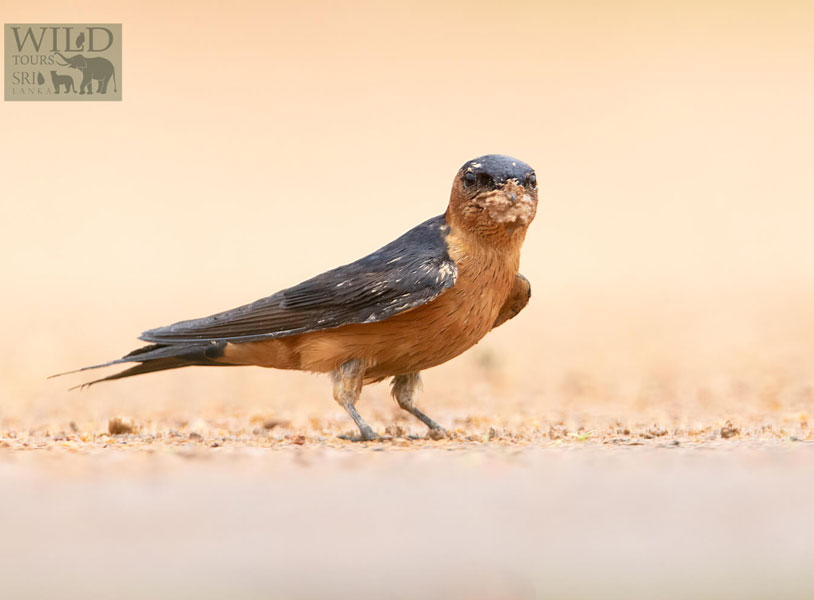
Sri Lanka Swallow (Cecropis hyperythra)
The Sri Lanka swallow is a distinctive bird with a deeply forked tail, featuring unstreaked chestnut underparts and rump. As a passerine, it has three toes pointing forward and one backward, allowing it to perch.This swallow is found in various open country habitats, including farm fields and lightly wooded areas, in both the lowlands and foothills. Typically observed in pairs or small groups. This species thrives in a variety of landscapes, contributing to the diverse birdlife in Sri Lanka's lowlands and foothills
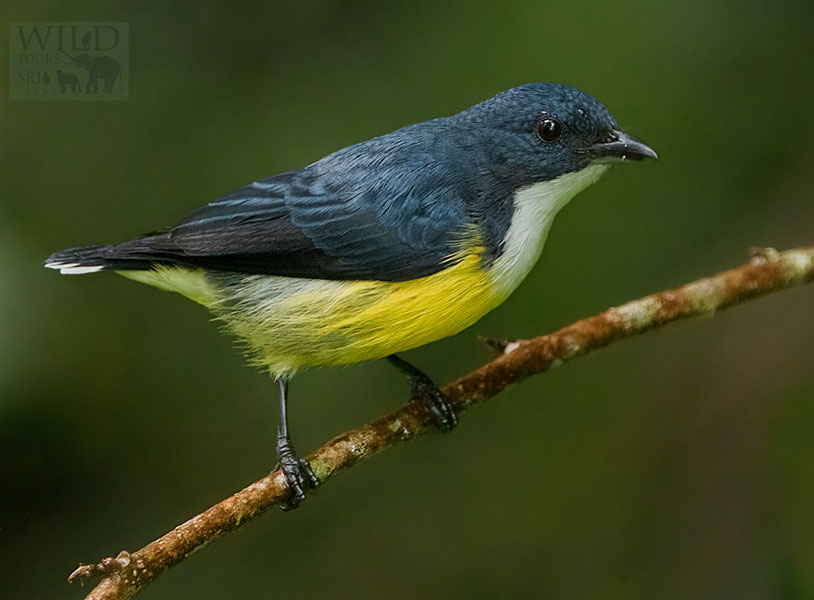
White-throated Flowerpecker (Dicaeum vincens)
The White-throated flowerpecker is a small and stout songbird measuring around 10 cm. With dark upperparts and a white throat, this bird is often found in pairs within wet forests. Its diet primarily consists of nectar, making it an essential part of the ecosystem, while its high-pitched calls add to the symphony of Sri Lanka's birdlife.
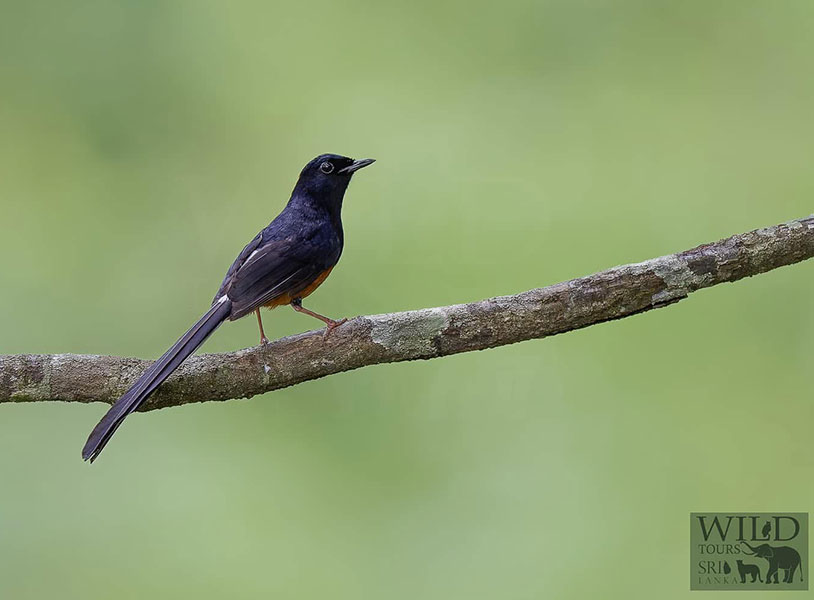
Sri Lankan Shama (Copsychus leggei)
The Sri Lankan shama is the newest addition to the list of endemic birds in Sri Lanka. Previously grouped with the White-rumped Shama (Copsychus malabaricus), recent studies have confirmed its status as a separate species unique to the island. The Sri Lankan Shama is known for its beautiful, melodious song and is often spotted in dense forests. This split from the White-rumped Shama resolves previous confusion in birdwatching records, making it important for birders in Sri Lanka to refer to this bird correctly. All existing records from Sri Lanka now refer specifically to the Sri Lankan Shama. As an endemic species, it plays a crucial role in the island's ecosystem, and efforts to conserve its habitat are vital to its survival.
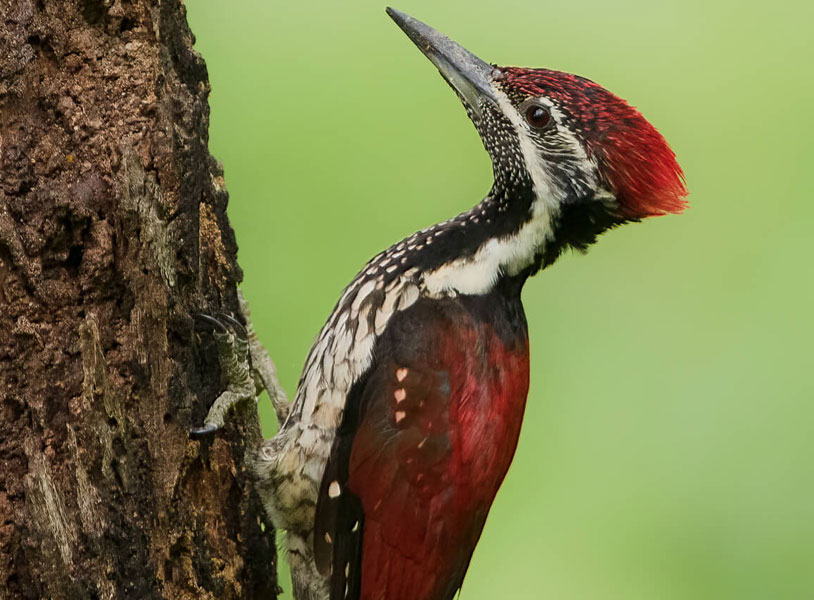
Red-backed Flameback (Dinopium psarodes)
The Sri Lankan shama is the newest addition to the list of endemic birds in Sri Lanka. Previously grouped with the White-rumped Shama (Copsychus malabaricus), recent studies have confirmed its status as a separate species unique to the island. The Sri Lankan Shama is known for its beautiful, melodious song and is often spotted in dense forests. This split from the White-rumped Shama resolves previous confusion in birdwatching records, making it important for birders in Sri Lanka to refer to this bird correctly. All existing records from Sri Lanka now refer specifically to the Sri Lankan Shama. As an endemic species, it plays a crucial role in the island's ecosystem, and efforts to conserve its habitat are vital to its survival.
